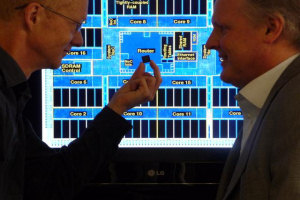University innovation takes centre stage at Conservative Party conference
01 Oct 2013
The University of Manchester has set up home in the Innovation Zone at the Conservative Party Conference being held at Manchester Central this week.

The University has four exhibits within the Innovation Zone, which have already been visited by Prime Minister David Cameron, Foreign Secretary William Hague and Health Secretary Jeremy Hunt, as well as hundreds of conference delegates.
Unsurprisingly, graphene features prominently in the exhibition and visitors to the stand can even get to make some of the wonder material using scotch tape and view it under a microscope. Delegates can also learn about the University’s National Graphene Institute (NGI), which will be the world’s leading centre of graphene research and commercialisation. The NGI will uniquely offer a collaborative research environment where industry and science can work side by side on developing new and exciting graphene applications. Set to open in early 2015, the £61m Institute is funded by the Engineering and Physical Sciences Research Council (EPSRC) and the European Regional Development Fund (ERDF).
Also exhibiting within the conference’s Innovation Zone is SpiNNaker, a massively parallel, low power, supercomputer currently being built by a team in the University’s School of Computer Science. It is designed to model very large, biologically realistic, spiking neural networks in real time. The machine is built to mimic the brain's biological structure and behaviour. With over one million cores, the machine will be capable of simulating up to one billion neurons, or around 1% of the human brain.
iMagiMat, also known as ‘the magic carpet’, is an intelligent mat made up of plastic optical fibres, laid on the underlay of a carpet. Conference-goers can see how the optical fibres can bend when they tread on it and map in real-time their walking patterns. iMagiMat maps 2D images by using light propagating in fibres under the surface of the smart carpet. Compact electronics at the edges measure and relay sensor signals to a computer. The signals are analysed to show the footprint image and identify gradual changes in walking, or a sudden incident such as a trip or fall, so a potential use for the carpet could be in nursing and care homes.
The final exhibit in the Innovation Zone is from University spin-out company, Nanoco. Nanoco Technologies Ltd designs, develops and manufactures quantum dots, solar inks and other nanomaterials for major end-use markets. The company is headquartered in Manchester, where its R&D activities are based and where it has built on a world-class core technology protected by a growing intellectual property estate.
Ends
